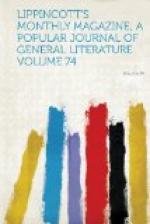It is Saturday evening, and the sun is just entering the heavy cloud-bank which rests on the western horizon as we drive up to the door. Our genial and venerable host, “the old doctor,” is at the stables superintending the feeding of his horses, and thither we bend our steps with a sense of exhilaration which only the crisp, fresh country air can impart, and a new vigor thrilling through every muscle as the foot presses the green and springy sod. Our old friend is a worthy representative of the old regime, the only change which the lapse of thirty years has made in his costume being the substitution of black for blue broadcloth in the velvet-collared, brass-buttoned, narrow-skirted coat with its side-pocket flaps. The collar sits as high in the neck; the red silk handkerchief peeps out behind; the trousers are cut with the “full fall,” over which hangs the watch fob-chain with its heavy seals; the low-crowned beaver hat has the same wide brim; and the silver snuff-box is still redolent of Scotch maccaboy.
“The hounds have got fat waiting for you, and the birds are almost tame enough to put salt on their tails,” says the old gentleman after the hearty welcome is over. “Old Nannie says the foxes are eating up all her turkeys, and Loudon tells me that he sees deer-tracks coming out of the new ground every morning.”
“How are ye, gentlemen?” says stout John Myers, the “obeshay,” which is negro for “overseer.”—“I say, there! you Cuffee, that basket ain’t half full o’ corn.—I s’pose you’re goin’ to clean out all the game by Chris’mas?—You Caesar, why don’t you fill up old Chester’s stall with trash? You niggers are gittin’ too lazy to live;” and he walks off to see that the negroes, who are watching us with open mouths and eyes, do not allow their astonishment to interfere with the comfort of the horses. Five sturdy negro men are doing the work of two boys, forking in the “pine-trash” from the huge pile outside, and bringing ear-corn in oak bushel-baskets on their shoulders from the corn-house three hundred yards away.




